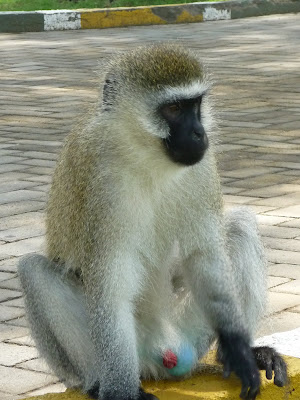
Africa is full of primates. Included among them are several close relatives to human kind, known as the great apes. We couldn't visit Africa without saying hello to our cousins. Although many primates are seen in abundant numbers in Africa, it was necessary to visit Uganda's famous Bwindi Impenetrable Forest to spot the prize of all primates; the elusive mountain gorilla. When we first heard the name of the park, we didn't really get the "impenetrable park." After machete hacking our way through the dense jungle and clambering down near verticle precipes for 7 sweaty hours, we better understood the meaning.

In addition to rough terrain, finding gorillas requires tracking. Tracking primates requires that you look for footprints, nests, and feces from the animals. Even finding signs is no guarantee you will find the animals. In Uganda's Queen Elizabeth park, we were foiled from finding chimpanzees by a band of foraging elephants. Luckily, our guide was well armed with a rifle and was able to scare them off, but the encounter ruined our opportunity to see the chimps.
Below, a chimpanzee nest in the tree; no one home, though!

Kelsi pointing out some gorilla poop... she smelled it out without trouble!

As we scanned the jungle floor for signs of gorillas, we became aware of life that we might have previously overlooked, including ant colonies. Safari ants, also called army ants, swarm in huge numbers in militaristic, agressive food gathering campaigns, and have been known to devour animals and even people who are unlucky enough to get caught in their way. At several times during our hike for the jungle, we had to pry them off of our skin as they bit into our skin. Interestingly, this also allows use of these ants as stitches for closing up wounds. The Masai tribes (depicted in our earlier safari blog), have also found a beneficial relationship with Safari ants. The Masai leave them alone in exchange for the ants performing something akin to biological pest control on Masai lands.

Fortunately, for the gorilla treking, we hired a knowlegable guide to accompany us, and he helped us to find the animals. Our reward upon finding the animals was being immediately charged by a 500 pound gorilla Silverback. The noise alone was terrifying, not to mention the chest beating and snarling.

Adult male mountain gorillas are called silverbacks because a saddle of silver-colored hair develops on their backs with age. Mountain gorilla groups are dominated by one dominant silverback, which can reach 5-6 feet in height, with an arm span over 7 feet, and weigh in at a massive 450–500 lbs. In addition to the gorillas, we also saw several other varieties of primates. Following are a few snapshots of them.
Baboon females love little baboon babies with bright crimson butts and black fur so much that they try to steal them from eachother. A baboon mother must very carefully watch over her baby.

The black and white colobus monkey is shy, and rightfully so. He is often the prey of choice for not only tree climbing leopards, but also for meat hungry chipmanzees.

Below is a male blue monkey. See if you can figure out why he is called "blue"...

In addition to primates, we enjoyed simply being in Africa and watching the women carrying home the loads on their heads. All of Africa is a rich collage of cultures, including many indigenous tribes.

2 comments:
hey that sounds LIke fun Addie loved all the animals and when I told her that you found poop she went ewwwwwwwww!and she loved acting like the gorilla and the monkey and when we looked at all the animals in the other post she made all the sounds even the heyenna. I have so much fun looking at your blog.
LOve Ashley and oiaefoihe (adalyn) :P
Wow, I got behind on your Odyssey, since we were traveling.
Glad to see you visited Hagia Sophia, and Italy, and ate Gelato. I loved Florence. We were in Austrian Alps about the time you were in Italy. Anyhow, I heard you're heading home for Kevin. So the year-long adventure is coming to a close.
I would love to see a picture of your suitcase contents! And read your thoughts after a year of living with only what you can carry.
Post a Comment